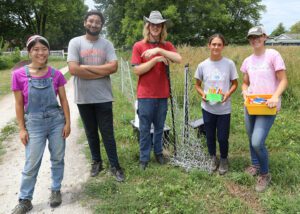Columbines are popular garden plants. They can be found in various colors, ranging from red, pink, yellow, white, purple, and blue, and they can help fill the gap between early spring blooming plants like tulips and daffodils and the summer blooming plants that dominate our landscapes.
Columbine flowers are unique and instantly recognizable. They have five petals that extend upwards, forming a tubular spur and five petal-like sepals. The flowers will often nod towards the ground, but some species, and many hybrids, will have upright-facing flowers.
Growing columbine in the garden
Columbines belong to the genus Aquilegia, which contains around 65 different species. One of the most popular columbines to grow is the native wild/Canadian/eastern red columbine, A. canadensis. It has yellow (sepals) and red (petals) flowers. However, several other species and numerous hybrids are available.
Columbines can range from 6 inches to 3 feet tall, depending on the species. They prefer moist, well-drained soils in light to partial shade, but will grow in full sun if the soil is kept moist. While they are perennials, they are often short-lived. However, some, like wild columbine, will readily self-seed and may spread throughout a landscape.
Columbine can also support a variety of wildlife. Not only are columbine flowers attractive to us humans, but they are also attractive to several different pollinators. The nectar is located deep in the spurs, so it is visited by pollinators with long tongues, like ruby-throated hummingbirds, bumble bees, and hawk moths.
Columbine is relatively pest-free; deer and rabbits may nibble on the foliage, but rarely feed heavily on it. However, there is one pest that may occasionally cause problems: columbine leafminers.
Columbine leafminers
There are a few species of leafminers that will attack columbines, but the most commonly encountered species in Illinois is the columbine leafminer, Phytomyza aquilegivora.
Columbine leafminers are flies and will overwinter in the soil as pupae. In the spring, adults will emerge, and females will lay eggs on the leaves of columbine plants, around the time they bloom. The larvae will tunnel into the leaves and feed between the upper and lower leaf surfaces, creating serpentine (snake-like) mines. Once the larvae are done feeding, they will cut a hole in the leaf and pupate on its underside. There are multiple generations per year.
Fortunately, the damage they cause is typically only cosmetic, but heavy infestations may reduce the vigor of plants. The damage can be ignored, but if leafminers are a concern on columbine, several things can be done to manage them.
- Removing and destroying infested leaves can help reduce larval populations; this should be done before they pupate.
- Removing and destroying infested plant parts and cultivating around infested plants can help reduce the number of overwintering pupae in the soil.
- Researchers in Georgia found that A. caerulea ‘Dwarf Fantasy Mix’, Wild columbine (A. canadensis), and fan-leaved columbine (A. flabellata) were less affected by leafminers than other species and cultivars. So, if you have issues with leafminers, consider growing these types of columbines.
- Chemicals are typically not recommended for the management of columbine leafminers. Once the larvae are inside leaves, contact insecticides will not work, so timing is critical. Additionally, they may also kill natural enemies and other beneficial insects that may be present…
- The same researchers in Georgia found eleven species of parasitoid wasps attacking columbine leafminers. While the leafminers will still do some damage before they are killed, the parasitoids will help reduce subsequent populations.
Good Growing Fact of the Week: Aquilegia is derived from aquila, meaning eagle, because the flower’s spurred petals resemble an eagle’s talons.
***Courtesy of the University of Illinois Extension***
















